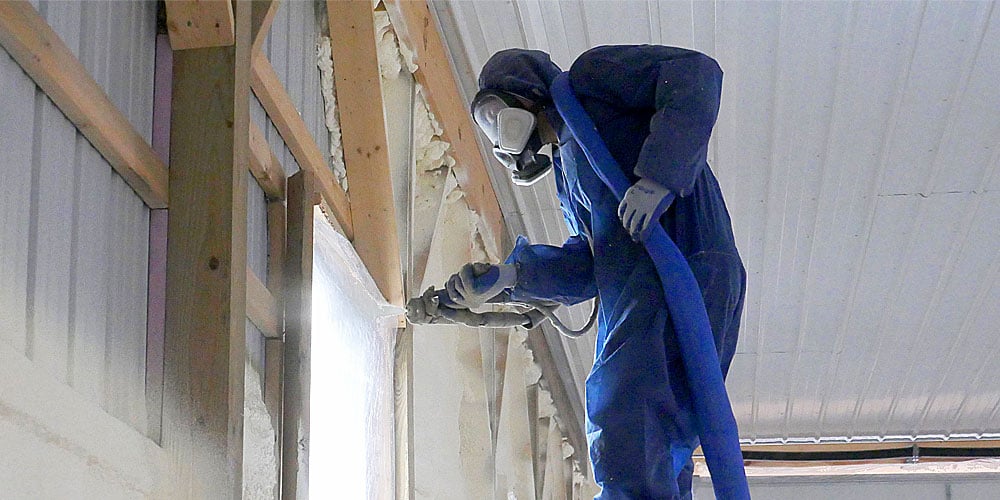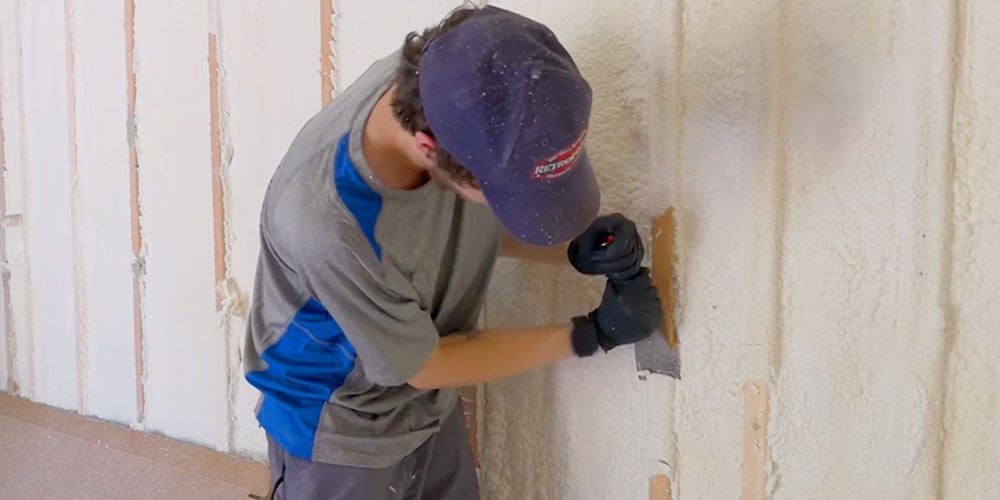Spray Foam: The Ultimate Remedy for Air Sealing and Insulation
Spray foam insulation has arised as a leading service for reliable air securing and thermal insulation, supplying an one-of-a-kind mix of homes that set it aside from conventional methods. Its capability to increase and fill up gaps makes it specifically reliable in stopping air leak, which can considerably impact power efficiency. Understanding the full scope of its advantages, installment processes, and contrasts with various other insulation types is essential for making notified decisions. As we explore these elements, the ramifications for both brand-new building and constructions and retrofits end up being progressively substantial. What factors should influence your choice?
What Is Spray Foam?
Spray foam is a functional insulation material that combines the concepts of air sealing and thermal resistance to enhance power performance in structures. Composed largely of polyurethane or other similar compounds, spray foam is applied as a fluid that broadens upon contact with surfaces, creating a strong, continual layer of insulation. This distinct residential or commercial property allows it to fill up gaps, fractures, and voids that standard insulation materials may neglect, offering an exceptional air seal.
There are two major kinds of spray foam: open-cell and closed-cell. Open-cell spray foam is lighter and a lot more flexible, supplying exceptional sound absorption and a reduced R-value per inch - Spray Foam. In comparison, closed-cell spray foam is denser, providing a higher R-value, wetness resistance, and added architectural stability to building elements
The application procedure usually includes specific devices, making sure a seamless application that sticks to numerous substrates, including concrete, wood, and steel. This adaptability makes spray foam suitable for both new constructions and retrofitting existing frameworks. Its ability to produce an airtight obstacle substantially contributes to decreasing power usage and improving interior air top quality, therefore making it a preferred option amongst contractors and property owners alike.
Advantages of Spray Foam Insulation
Among one of the most significant advantages of spray foam insulation is its remarkable capacity to develop a continuous air obstacle, which effectively minimizes power loss. Unlike standard insulation products, spray foam expands to load splits and spaces, ensuring that air leak is substantially reduced. This particular not only enhances power efficiency yet additionally brings about reduce utility expenses over time.
Furthermore, spray foam insulation gives remarkable thermal resistance, contributing to a much more stable indoor atmosphere. Its high R-value per inch allows for reliable insulation in restricted spaces, making it suitable for attics, walls, and crawl spaces. Moreover, the moisture-resistant homes of spray foam aid avoid mold and mildew development, advertising much healthier living conditions.
An additional critical benefit of spray foam insulation is its sound-dampening qualities (Spray Foam). It efficiently minimizes noise transmission in between spaces, producing a quieter and more comfortable home setting. The toughness of spray foam additionally attracts attention, as it does not droop or settle over time, preserving its efficiency throughout its lifespan
Exactly How Spray Foam Works
Recognizing exactly how spray foam insulation functions is necessary for valuing its efficiency in air sealing and thermal resistance. Spray foam insulation contains 2 key elements: isocyanate and polyol resin. When these elements are blended, they undertake a chain reaction that creates the product to broaden swiftly, producing a dense foam that fills spaces, cracks, and dental caries.
As the foam increases, it complies with surface areas, forming an impermeable seal that significantly reduces air infiltration. This particular makes spray foam insulation very effective at avoiding drafts and moisture penetration, which can bring about energy loss and damages with time. Additionally, the closed-cell variant of spray foam uses remarkable thermal resistance due to its rigid structure, efficiently minimizing heat transfer.
The unique residential properties of spray foam enable it to conform to irregular surfaces, making sure thorough insurance coverage and a seamless barrier. Because of this, spray foam insulation not just improves energy performance but additionally adds to boosted interior air quality by decreasing the build-up of contaminants and irritants. Ultimately, comprehending the technicians behind spray foam highlights its duty as a premium selection for insulation and air sealing in both residential and commercial applications.
Installment Refine Review

Before installation, the room has to be appropriately cleansed and prepped, making sure that surfaces are devoid of dust, debris, and wetness. Due to the fact that pollutants can endanger bond and general performance, this action is vital. When the location is prepared, the application includes blending the two parts of the spray foam, which broadens upon get in touch with and fills up voids successfully.
Trained professionals should conduct the setup, using customized tools to make sure consistent coverage and optimum thickness. Security preventative measures, consisting of putting on click this site protective equipment and making sure correct ventilation, are essential during this procedure. After application, the foam generally treatments rapidly, creating a solid obstacle that boosts energy effectiveness.
Comparing Spray Foam to Typical Insulation
When examining insulation alternatives, spray foam insulation stands out in contrast to traditional materials such as fiberglass and cellulose. Unlike fiberglass and cellulose, which can permit air seepage, spray foam broadens upon application, filling spaces and crevices to create an impermeable seal.
Additionally, spray check it out foam offers a greater R-value per inch than conventional insulation kinds, using even more reliable thermal resistance in a thinner profile. This characteristic is specifically useful precede with limited tooth cavity deepness. In addition, spray foam is resistant to moisture and mold and mildew development, which can be a considerable worry about cellulose and fiberglass, particularly in damp settings.
Nevertheless, spray foam insulation commonly brings a greater upfront cost than its standard counterparts. House owners must weigh this initial investment against long-term energy financial savings and efficiency benefits. Eventually, while both insulation types offer their purpose, spray foam becomes an advanced remedy for modern insulation needs, specifically in terms of air securing and thermal effectiveness.

Conclusion
In summary, spray foam insulation stands for an extremely reliable solution for attaining optimal air securing and thermal resistance. Its distinct residential properties, consisting of moisture resistance and audio dampening, make it suitable for different applications in both new buildings and retrofitting projects (Spray Foam). The initial costs might be greater compared to conventional insulation materials, the long-lasting advantages, such as considerable power financial savings and improved interior air high quality, warrant the financial investment and emphasize its worth in contemporary building techniques.
Spray foam insulation has emerged as a leading solution for effective air securing and thermal insulation, using an one-of-a-kind mix of properties that set it apart from conventional techniques.Spray foam is a versatile insulation product that incorporates the principles of air sealing and thermal resistance to enhance power click performance in structures.When assessing insulation alternatives, spray foam insulation stands out in contrast to conventional materials such as fiberglass and cellulose. Ultimately, while both insulation kinds offer their function, spray foam arises as a more sophisticated solution for modern-day insulation needs, specifically in terms of air securing and thermal performance.
In summary, spray foam insulation stands for an extremely reliable remedy for attaining ideal air securing and thermal resistance.